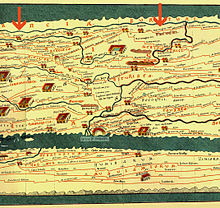Harenatium
| Kleve cattle fort | |
|---|---|
| Alternative name | Harenatium |
| limes | Lower Germanic Limes |
| Dating (occupancy) | 1st to the end of the 3rd century |
| Type | Auxiliary fort (?) |
| unit | unb. |
| size | unb. |
| Construction | Stone fort |
| State of preservation | no longer visible above ground |
| place | Cattle |
| Geographical location | 51 ° 48 '48 " N , 6 ° 7' 42" E |
| height | 17 m above sea level NHN |
| Previous | Carvium (Rijnwaarden Fort) (north-north-west) |
| Subsequently | Quadriburgium (Qualburg Castle) (south-southeast) |
Harenatium , also called Fort Kleve-Cattle , was a presumed Roman fortification on the Lower Germanic Limes in the 1st to 3rd centuries. The place was on a now silted up arm of the Rhine . Today's ground monument is located in the locality of Cattle , a district of the city of Kleve on the Lower Rhine . The church of St. Willibrord today marks the center of the Roman settlement area.
Sources and research history
Tacitus mentions the place in his description of the Batavian revolt . According to this, the legio X Gemina is said to have moved into winter storage there in the autumn of 70. The Tacitus manuscripts name the place Arenacium . Under this designation Arenatio also leads Tabula Peutingeriana place. In contrast, the Antonini itinerary, which was previously dated , first handed down the place name Harenatium .
During construction work in the years 1870 to 1872, the foundations of a Roman thermal baths from the 2nd / 3rd centuries were laid on the north side of St. Willibrord . Century found, which could possibly have been the fort bath. Further hypocausted building remains were discovered during excavations in 1980.
Finds
The earliest finds of Terra Sigillata from the area around St. Willibrord are dated to the second half of the 1st century. Brick stamps of vexillations of the legio I Minerva , the legio X Gemina and the legio XXII Primigenia attest to the military character of the site.
The finds of two inscriptions testify to the worship of the Batavian goddess of war Vagdavercustis . The inscriptions were used as spoilers in the medieval St. Willibrord's Church, which was demolished in 1870.
Monument protection
The fort and the area of the camp service are ground monuments according to the law for the protection and care of monuments in the state of North Rhine-Westphalia (Monument Protection Act - DSchG) . Research and targeted collection of finds are subject to approval. Incidental finds are to be reported to the monument authorities.
See also
literature
- Anna-Barbara Follmann : Kleve cattle - Harenatium . In: Julianus Egidius Bogaers and Christoph B. Rüger (eds.): The Lower Germanic Limes. Materials on its story . Rheinland-Verlag, Cologne 1974, ISBN 3-7927-0194-4 , pp. 93-95.
- Michael Gechter : The beginnings of the Lower Germanic Limes. In: Bonner Jahrbücher 179, 1979, Rheinland-Verlag, Bonn 1979.
- Friedrich Gorissen : Cattle (Harenatium - Rinharen). Roman Limes fort, Anglo-Scottish Coenobium Willibrords, feudal manorial power and glory, Deichschau . Vol. 1: From the beginning of settlement to the end of glory. Presentation and sources . Verlag für Kultur und Technik, Kleve 1985, ISBN 3-924637-04-0 , pp. 11-21.
- Heinz Günter Horn : The Romans in North Rhine-Westphalia . Theiss, Stuttgart, 1987, ISBN 3-8062-0312-1 , pp. 458 f.
- Hans-Helmut Wegner : Excavations in the Rhineland 1979/80. Exhibition Rheinisches Landesmuseum Bonn 1981, Bonn 1981, p. 171 ff.


